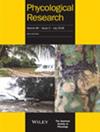Species diversity and distribution of the calcareous green macroalgae Halimeda in Taiwan, Spratly Island, and Dongsha Atoll, with the proposal of Halimeda taiwanensis sp. nov.
IF 1
4区 生物学
Q2 MARINE & FRESHWATER BIOLOGY
引用次数: 0
Abstract
The calcified green algal genus Halimeda is one of the most ecologically important but morphologically diverse seaweeds in sub‐tropical and tropical waters. Because of its high morphological plasticity, the identification of Halimeda species based on morphological characters is challenging without the assistance of molecular analysis. To date, the species diversity of Halimeda in Taiwan and its overseas territories has not been investigated with the assistance of DNA sequencing, and this taxonomic knowledge gap should be filled. The present study initiates a systematic examination of the species diversity and distribution of Halimeda in Taiwan, Spratly Island, and Dongsha Atoll in the South China Sea, using DNA sequence data (plastid tufA gene and rbcL) and morphological data. Our DNA analyses revealed the presence of 10 Halimeda species (Halimeda borneensis, Halimeda cylindracea, Halimeda discoidea, Halimeda distorta, Halimeda macroloba, Halimeda minima, Halimeda opuntia, Halimeda renschii, Halimeda taiwanensis sp. nov., and Halimeda velasquezii) in the waters around Taiwan, Spratly Island, and Dongsha Atoll. The majority of the species could be readily distinguished by their morphological and anatomical characters. The proposed new species, H. taiwanensis, was differentiated not only by our algorithmic species delimitation analyses (statistical parsimony network analysis and automated barcode gap discovery), but also by its morphological features. The proposed new species differs from two externally resembled species, H. cuneata and H. discoidea, in having an undulated segment margin, the complete fusion of medullary siphons at the node, the lack of segment stalk, and the presence of a large primary utricle. Here, we present the up‐to‐date taxonomic account, molecular diversity, and geographical distribution of Halimeda spp. in Taiwan and associated areas of the South China Sea. Environmental factors that might drive the occurrence and latitudinal distribution of the species are also discussed.台湾、斯普拉特利岛和东沙环礁石灰质绿藻的物种多样性和分布。
钙化绿藻属Halimeda是亚热带和热带水域中最具生态重要性但形态多样的海藻之一。由于其高度的形态可塑性,如果没有分子分析的帮助,基于形态特征鉴定Halimeda物种是具有挑战性的。到目前为止,台湾及其海外地区的Halimeda物种多样性尚未通过DNA测序进行调查,这一分类知识空白应予填补。本研究利用DNA序列数据(质体tufA基因和rbcL)和形态学数据,对台湾、南沙岛和南海东沙环礁的Halimeda物种多样性和分布进行了系统的研究。我们的DNA分析揭示了台湾、斯普拉特利岛和东沙环礁周围水域中存在10种Halimeda物种(Halimeda borneensis、Halimeda cylindracea、Halimedia discoide、Halimedadistortha、Halimedatamacroloba、Halimida minima、Halimedata opuntia、Halimeada renschii、Halimedan taiwanensis sp.nov.和Halimeda velasquezii)。大多数物种可以很容易地通过它们的形态和解剖特征来区分。所提出的新物种黄山H.不仅通过我们的算法物种划界分析(统计简约网络分析和自动条形码缺口发现)进行了区分,还通过其形态特征进行了区分。所提出的新物种不同于两个外部相似的物种,H.cuneata和H.discodeidea,因为它们具有波状的节边缘,节处的髓质虹吸管完全融合,缺乏节柄,并且存在大的初级胞囊。在此,我们介绍了台湾和南中国海相关地区Halimeda spp.的最新分类说明、分子多样性和地理分布。还讨论了可能驱动该物种发生和纬度分布的环境因素。
本文章由计算机程序翻译,如有差异,请以英文原文为准。
求助全文
约1分钟内获得全文
求助全文
来源期刊

Phycological Research
生物-海洋与淡水生物学
CiteScore
3.60
自引率
13.30%
发文量
33
审稿时长
>12 weeks
期刊介绍:
Phycological Research is published by the Japanese Society of Phycology and complements the Japanese Journal of Phycology. The Journal publishes international, basic or applied, peer-reviewed research dealing with all aspects of phycology including ecology, taxonomy and phylogeny, evolution, genetics, molecular biology, biochemistry, cell biology, morphology, physiology, new techniques to facilitate the international exchange of results. All articles are peer-reviewed by at least two researchers expert in the filed of the submitted paper. Phycological Research has been credited by the International Association for Plant Taxonomy for the purpose of registration of new non-vascular plant names (including fossils).
 求助内容:
求助内容: 应助结果提醒方式:
应助结果提醒方式:


